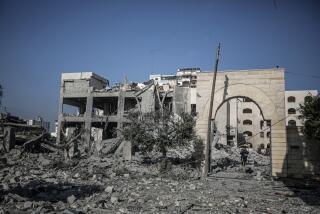Past Treasures Are at Risk in Today’s War : Archeology: Allied bombing of Iraq is imperiling relics of ancient civilization and one of the world’s richest historical troves.
- Share via
CHICAGO — Allied bombing of Iraq is endangering one of the world’s richest archeological regions and treasures from the earliest civilizations, archeologists and historians say.
“It’s one of the more unfortunate places in the world where this could happen,” said Mike Shoemaker, assistant editor of Biblical Archeology Review, a Washington-based publication.
Baghdad, among the heaviest hit areas, is at the eastern edge of ancient Mesopotamia, a region between the Tigris and Euphrates rivers that was settled before 4000 BC.
“It’s where we have the first writing, it’s where we have the first cities, it’s where we have the first monumental architecture. All of these things are the base of all modern civilization,” said McGuire Gibson, a professor of Mesopotamian archeology at the University of Chicago.
One of the most endangered sites is the Iraq National Museum in downtown Baghdad, where thousands of treasures such as clay writing tablets and jewelry are housed, Shoemaker said.
“What’s most horrible about it is (that) it is located right next door to the main railroad station,” Gibson said. “A television and radio station are within 500 feet of the museum.”
A blast near the museum likely would damage its fragile treasures, Gibson said.
“There’s no telling what’s been destroyed,” he said. “The museum is not made to take that kind of pounding.”
The Defense Ministry partly surrounds the Abbasid Palace, one of Baghdad’s major standing monuments. The yellow brick structure, dating to about AD 1200, is one of Iraq’s few intact historic monuments.
Gibson said he has been unable to contact museum workers and friends to find out the extent of bomb damage.
“I would guess there’s been some damage because the Defense Ministry has been hit,” he said.
A Pentagon spokesman said U.S. officials “are not discussing specific results of targeting.”
“We’ve said we’ve hit military sites, we’re not going after holy sites,” said the spokesman, who would not allow his name to be used.
But in southern Iraq, Gibson said, an air base “which is being hammered constantly” by bombs is adjacent to the ancient city of Ur, said to have been the birthplace of the biblical patriarch Abraham.
“We’re seeing on TV only the smart bombs that hit” their designated targets, Gibson said. “We don’t see the ones that miss.”
Another endangered site is at Samarra, reportedly the site of a chemical weapons plant targeted by the allies about 90 miles north of Baghdad, Gibson said.
The remains of an Islamic city dating to AD 800 “are in very grave danger” there, he said.
Before war broke out on Jan. 16, noted archeologist Robert McCormick Adams, secretary of the Smithsonian Institution, predicted that no “calamitous” damage would be done to ancient sites except those near modern cities and other potential targets.
Madeleine Jacobs, director of public affairs for the Smithsonian, said last month that Adams wished to do no further interviews on the subject.
“He does wish to note, though, that he considers the entire situation tragic, but he is more concerned for the people of Iraq than he is for archeological sites,” Jacobs said.
Gibson said the war forced him to cancel his annual winter research trip to Iraq.
“What you’re going to do is alter the landscape to a point where . . . certain types of research that we do will not be able to be done again,” he said.
Some are reluctant to discuss the situation, fearing that the Iraqis will misinterpret their words and bar them from the country.
“Even if the country’s reconstructed . . . I think there would still be a lot of resentment of Western archeologists,” Shoemaker said.
More to Read
Sign up for Essential California
The most important California stories and recommendations in your inbox every morning.
You may occasionally receive promotional content from the Los Angeles Times.













